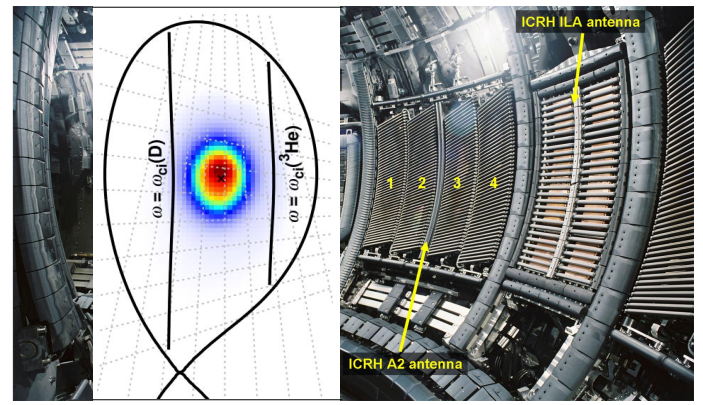Heating challenge
Sometimes the way to solve a tricky problem is to make it more complex. Take the challenge of heating up a fusion device that fusion researchers face. To recreate the power source of the sun they need to heat a mixture of charged hydrogen ions and electrons (a plasma) to temperatures of 150 million degrees.
Heating a plasma is tricky, though. When you try to heat a plasma with a balanced mix of two different ions using radiofrequency waves, the balance of the plasma can shift so that ions respond less and less to your heating attempts.
It turns out that you can rebalance the plasma by adding a third type of ion (hence “three-ion heating”), explain EUROfusion physicists Yevgen Kazakov and Jozef Ongena from the Royal Military Academy in Brussels, the leading authors of the paper.
Describing their collaborative research with more than 60 colleagues worldwide, the authors compile everything you need to know to use the three-ion heating technique. “All the essential techniques were already known”, explains Kazakov. “But it wasn’t realized that you can combine them into a very powerful and flexible tool.”

Mimicking fusion alphas
The real test of fusion as an energy source will be the international device ITER, designed to be the first fusion device that can produce more heat from fusion than it takes to keep the reactions going. ITER plasmas will be primarily heated by the fast helium ions (also known as alpha particles or alphas) produced by the fusion reaction. Existing fusion devices cannot replicate those conditions because they cannot produce enough fusion reactions.
Fusion researcher Athina Kappatou (Max-Planck Institute for Plasma Physics, Germany) recently published new research on the physics of energetic helium ions generated with the three-ion heating in ASDEX Upgrade experimental fusion device. “A big question is how the alpha particles will influence the surrounding plasma”, explains Kappatou. “Will they exit too fast before transferring all their energy or do they have a stabilizing effect on the plasma? With the three-ion heating scheme, we can mimic fusion alpha particles and predictively study how they will behave in ITER when the high-performance experiments start.”

Calming effect
Signs are good that three-ion heating is here to stay, thinks EUROfusion JET task force leader Jeronimo Garcia (CEA, France): “One worry we always had is that these fast alphas might disturb the plasma”, he explains. Like a pressurized blob of jello, a plasma tends to react unkindly when it is prodded or poked, leaking energy or even collapsing entirely.
Garcia: “When we produced energetic helium ions with three-ion heating in JET, we were afraid they would wake up a whole zoo of instabilities called Alfvén eigenmodes that can degrade the plasma performance. But the reverse happened: we found that energetic ions actually have a calming effect on the plasma.”
Whether such a stabilizing effect from fusion-born alphas will work in ITER is still unclear, but one thing is certain: fusion researchers are eager to try out all they have learned.
